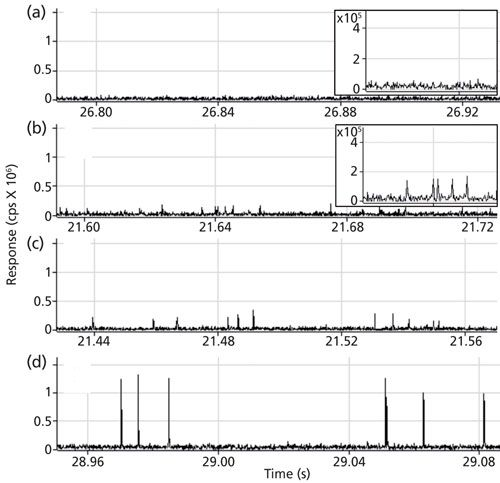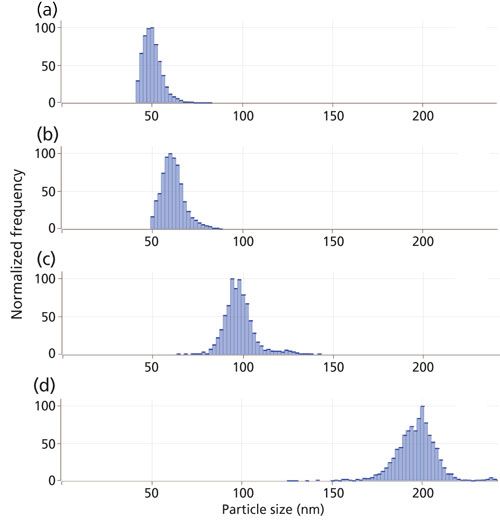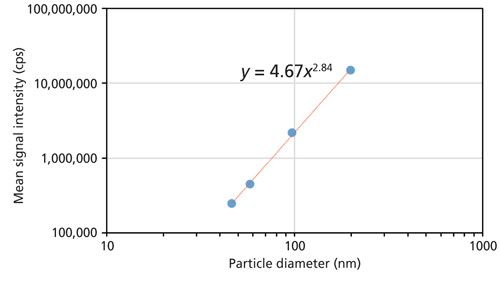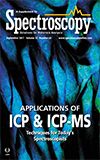Accurate Measurement of Ultrafine Silica Nanoparticles Using ICP-MS/MS
Special Issues
A method to measure ultrafine silica nanoparticles using ICP-MS/MS to control the elemental and polyatomic ion backgrounds is described here.
Silica (SiO2) nanoparticles (NPs) are widely used in industry, manufactured goods, and consumer products, such as food additives. However, there are several significant challenges associated with the measurement of silicon by inductively coupled plasma–mass spectrometry (ICP-MS). First, silicon has a moderately high first ionization potential (8.152 eV), which means it is less than 70% ionized in a typical argon plasma, so the sensitivity is significantly lower than for a fully ionized element. In addition, background polyatomic ions affect all three silicon isotopes, 28Si, 29Si, and 30Si, with the most intense interferences (14N2+ and 12C16O+) occurring on the major 28Si isotope. Finally, silicon-based materials are widely used in manufactured goods and industrial materials ranging from glass, alloys, and air and water filters to organic compounds such as silicone tubing, sealants, adhesives, lubricants, and coatings. Consequently, maintaining a low background for silicon in the analytical laboratory can be highly problematic. When characterizing silica in nanoparticle form, the analysis is especially difficult. In this article, we describe a method to measure ultrafine silica nanoparticles using ICP–tandem MS (ICP-MS/MS) to control the elemental and polyatomic ion backgrounds. The method provides high sensitivity to ensure accurate analysis at the small (~50 nm) particle sizes of interest in environmental and biological applications.
Nanomaterials are increasingly used in industrial processes, manufactured goods, medicines, and as ingredients in consumer products such as cosmetics, sunscreen, and food. The measurement of nanoparticles (NPs) is a subject of interest because the fate of NPs in the environment and the potential for toxic effects once absorbed into biological systems are not yet well understood.
Some of the most common types of NPs are difficult to measure accurately using conventional single-quadrupole inductively coupled plasma–mass spectrometry (ICP-MS). Such instruments often cannot achieve the combination of high sensitivity and low background that is required to allow the signal generated from a small particle to be distinguished from the background. Much of the work reported thus far has concentrated on particles that contain elements such as zirconium, silver, and gold (1,2), which are relatively easy to measure by ICP-MS. However, many of the natural and engineered NPs of interest are composed of elements that are much more difficult to measure by ICP-MS-for example, iron, sulfur, titanium, and silicon.
Nanostructured synthetic amorphous silica (SAS) is one of the most commonly used nanomaterials. It is an authorized food additive (E-551) and is also found in a wide variety of industrial and consumer products from polymers, composites, paints, and textiles to toothpastes, detergents, and cosmetics. Silica NPs also have great potential for a variety of other uses, including silica aerogels as thermal and electrical insulators, and imaging and therapeutic applications in medicine (3). Reliable analytical methods are needed to allow monitoring of compliance with upcoming regulations (4) and for the assessment of nano-safety (5). However, Si measurement by ICP-MS is not easy because of the combination of relatively low sensitivity and high spectral background. Silicon is only about 70% ionized and the major isotope (28Si – 92.23% abundance) is interfered by the intense background polyatomic ions CO+ and N2+. These limitations mean that conventional single-quadrupole ICP-MS is unable to detect silica particles with diameters smaller than about 200 nm (6). This capability is not sufficient for characterization of the nanoscale particle sizes of interest in emerging applications and for regulatory requirements; the accepted definition of a nanomaterial is one with major dimensions of 100 nm or less (7).
The interferences on Si+ can be resolved using a reactive cell gas such as hydrogen (H2) or ammonia (NH3) in the collision–reaction cell (CRC) of an ICP-MS system. However, ion–molecule reaction chemistry can only be controlled effectively using a tandem mass spectrometer, where an additional mass filter is situated before the CRC of the ICP-MS system. This extra mass filter enables MS/MS operation, where nontarget ions are prevented from entering the cell. This approach ensures that reaction processes and the resulting reaction product ions are consistent, even when the sample composition is complex or variable. The general layout and performance capability of a triple-quadrupole configuration of tandem ICP-MS is described in the literature (8).
In this work, various sizes of SiO2 NPs were measured by single-particle ICP-MS (spICP-MS), using MS/MS mode and H2 reaction gas on a triple-quadrupole ICP-MS system. The instrument software included an optional single nanoparticle application module for method development, signal processing, and data interpretation. The practical applications capabilities of the instrument for the measurement of a range of SiO2 NP sizes are discussed.
Experimental
Instrumentation
An Agilent 8900 ICP-QQQ system (model #100, Advanced Applications Configuration) was used for the analysis of silica nanoparticles. The instrument was equipped with a glass concentric nebulizer, a quartz spray chamber, a quartz torch with a 1-mm injector, and standard nickel sampling and skimmer cones. Samples were introduced with a standard peristaltic pump and pump tubing (1.02 mm i.d.). The configuration of the instrument used has a novel argon gas delivery path that uses special inert materials to minimize contamination of the gas supply through the instrument, reducing the elemental background for common contaminant elements Si and S. 28Si was measured in continuous fast time-resolved analysis (fast TRA) mode, using a dwell time of 0.1 ms (100 μs) per point with no settling time between measurements. The 28Si signal was measured on-mass in MS/MS mode, with both quadrupoles (Q1 and Q2) set to m/z 28. Hydrogen cell gas was used to resolve the on-mass polyatomic interferences, N2 and CO. The main operating conditions of the instrument are shown in Table sI online; please visit www.spectroscopyonline.com/supplementary-information-accurate-measurement-ultrafine-silica-nanoparticles-using-icp-msms.
Reference Materials and Sample Preparation
SiO2 NP reference materials with nominal diameters of 50, 60, 100, and 200 nm determined by transmission electron microscopy (TEM) were purchased from nanoComposix. The reference materials were diluted with deionized (DI) water to give particle concentrations of 40, 40, 100, and 1000 ng/L (ppt) for the 50-, 60-, 100-, and 200-nm particles, respectively. The solutions were sonicated for 5 min before analysis to ensure sample homogeneity. To allow the elemental response to be calculated, a Si ionic standard of 5 μg/L (ppb) was prepared in DI water. MS/MS with H2 cell gas should be effective in removing the CO+ interference on 28Si+, as well as the N2+ polyatomic overlap. To check this interference removal capability, a SiO2 NP solution containing a matrix of 1% ethanol was also prepared.
Time-Resolved Signals of SiO2 NPs
NPs measured using TRA with ICP-MS give a narrow peak or signal plume lasting around 0.5 ms for each particle that passes through the plasma; the peak signal area of each particle plume is proportional to the particle mass. The signals measured in DI water (without particles) and in solutions containing SiO2 particles with diameters of 50, 60, and 100 nm are shown in Figure 1. Fast TRA mode allows multiple measurements to be made during the signal peak from each individual particle. The shape and duration of the ion plume from each NP can be measured, and the total ion count can be converted to a particle mass and therefore diameter (assuming spherical particles). The Single Nanoparticle Application module of the ICP-MS MassHunter software includes the calculations to convert signal intensity to particle diameter, along with other key parameters, such as minimum detectable particle size and background equivalent diameter. Because of the high sensitivity, low elemental background, and effective interference removal of the ICP-MS instrument used, the smallest (50-nm) SiO2 particles provided clear signal peaks (Figure 1b) that were easily distinguished above the low background signal seen in DI water (Figure 1a). As expected, the 60-nm and 100-nm particle solutions gave proportionally higher signal peaks as shown in Figures 1c and 1d, respectively.
Figure 1: Silica nanoparticle signal pulses acquired using fast time-resolved analysis mode with a 0.1-ms dwell time: (a) DI water, (b) 50-nm NPs, (c) 60-nm NPs, and (d) 100-nm NPs. Inset plots are zoom views of (a) and (b).

Results
Frequency distributions were calculated automatically by the instrument software from the signals measured for the four SiO2 nanoparticle solutions shown in Figure 1; the frequency distribution plots are shown in Figure 2. The particle signals were clearly separated from the background caused by the dissolved ionic component, although the background and particle signals were partially overlapped for the 50-nm particles (shown in Figure 2b). From these results, we can estimate that the practical detection limit for the particle diameter was below 50 nm. The background equivalent diameter (BED) calculated by the instrument software from the 50-nm particle solution was 22 nm.
Figure 2: Frequency distribution for SiO2 NP signals: (a) DI water, (b) 50-nm NPs (40 ng/L), (c) 60-nm NPs (40 ng/L), and (d) 100-nm NPs (100 ng/L).

The particle size distribution results for the different SiO2 NP solutions are shown in Figure 3. The plots confirm that all the SiO2 particle sizes could be determined accurately, including the 50 nm NPs. The high sensitivity and low background of triple-quadrupole ICP-MS combined with the effective removal of polyatomic interferences in MS/MS mode with H2 cell gas, enabled the smaller NP sizes to be clearly distinguished from the background signal. All the particle size plots demonstrated a Gaussian distribution, which agrees with the information provided by the supplier of the NP solutions. The triple-quadrupole ICP-MS results obtained for median, mode, and mean particle sizes also agreed well with the reference sizes obtained by TEM (Table I). Also, the measured particle concentrations agreed well with the theoretical particle concentrations, although the concentration result for the 50-nm solution was slightly high (49 ng/L compared to an expected value of 40 ng/L) because of the overlap with the background signal.
Figure 3: Particle size distributions calculated for SiO2 NPs: (a) 50 nm, (b) 60 nm, (c) 100 nm, and (d) 200 nm.


Figure 4 shows the mean signal intensity measured by spICP-MS/MS plotted against the reference particle diameter determined by TEM. The logarithmic plot has a slope of 2.84, which is in good agreement with the theoretical cube relationship between diameter and mass indicated in equation 1:

Equation 1 is used to calculate particle mass (mp) from the diameter (d) and material density (ρ).
Figure 4: Plot of mean measured signal intensity (by spICP–MS/MS) versus reference particle diameter (by TEM).

Resolving Carbon Interference Using MS/MS and H2 Cell Gas
Real samples of interest-such as biological materials, food matrices, polymers, pharmaceutical ingredients, and organic solvents-may contain a high level of carbon, which causes a 12C16O polyatomic ion interference on 28Si. Triple-quadrupole ICP-MS in MS/MS mode with H2 cell gas can eliminate this interference effectively. A mixed solution of the 100-nm and 200-nm SiO2 NPs was prepared in a sample containing 1% ethanol. The particle size distribution for this sample is shown in Figure 5. Despite the high concentration of carbon, the size distribution for each group of particle sizes was consistent with the result obtained by TEM, and the different particle sizes were separated with excellent resolution. This result suggests that the spICP-MS/MS technique can resolve the carbon interference successfully, allowing accurate determination of particle sizes for SiO2 nanoparticles in natural sample matrices.
Figure 5: Particle size distribution for a mixed solution of 100-nm and 200-nm SiO2 NPs in 1% ethanol.

Conclusions
Triple-quadrupole ICP-MS operating in MS/MS mode with H2 cell gas was used for the successful determination of SiO2 nanoparticles at sizes smaller than 100 nm. The triple-quadrupole ICP-MS method delivered exceptionally low background signals and high sensitivity, allowing the smallest (50-nm) SiO2 particles to be distinguished from the background signal. MS/MS operation gave effective control of the H2 reaction chemistry, eliminating polyatomic interferences from N2 and CO, even in the presence of a high level of carbon matrix. Dedicated software was used to calculate the particle sizes, providing accurate results for individual NP reference materials and mixed solutions. The spICP-MS/MS method provided fast analysis times, excellent detection limits for particle size and concentration, and accurate results for SiO2 particles less than 100 nm.
References
- J. Tuoriniemi, G. Cornelis, and M. Hassellöv, Anal. Chem. 84, 3965−3972 (2012).
- C. Degueldre, P.-Y. Favarger, and C. Bitea, Anal. Chim. Acta518, 137−142 (2004).
- D. Napierska, L.C.J. Thomassen, D. Lison, J.A. Martens, and P.H. Hoet, Part. Fibre Toxicol.7, 39 (2010).
- L. Calzolai, D. Gilliland, and F. Rossi, Food Addit. Contam. 29, 1183−1193 (2012).
- S. Dekkers, A.G. Oomen, E.A. Bleeker, R.J. Vandebriel, C. Micheletti, J. Cabellos, G. Janer, N. Fuentes, S. Vázquez-Campos, T. Borges, and M.J. Silva, Regul. Toxicol. Pharmacol.80, 46−59 (2016).
- M.D. Montaño, B.J Majestic, Å.K. Jämting, P. Westerhoff, and J.F. Ranville, Anal. Chem.88(9), 4733−4741 (2016).
- International Organization for Standardization, ISO TS 80004-1:2010: Nanotechnologies - Vocabulary - Part 1: Core terms, available at: https://www.iso.org/standard/51240.html.
- L. Balcaen, E. Bolea-Fernandez, M. Resano, and F. Vanhaecke, Anal. Chim. Acta894, 7−19 (2015).
Ed McCurdy is with Agilent Technologies in Stockport, UK. Michiko Yamanaka is with Agilent Technologies in Tokyo, Japan. Steve Wilbur is with Agilent Technologies in Bellevue, Washington. Direct correspondence to: ed_mccurdy@agilent.com

Trending on Spectroscopy: The Top Content of 2024
December 30th 2024In 2024, we launched multiple content series, covered major conferences, presented two awards, and continued our monthly Analytically Speaking episodes. Below, you'll find a selection of the most popular content from Spectroscopy over the past year.
Best of the Week: Hyperspectral Imaging, ICP-MS Analysis of Geological Samples, Product Roundup
October 18th 2024Top articles published this week include an article about hyperspectral imaging in human skin research, a peer-reviewed article about analyzing geological samples using atomic spectroscopy techniques, and an equipment roundup piece about the latest products in the industry.